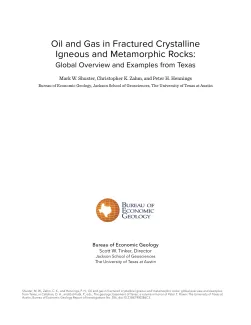
Publication Details
Get the Publication
$8.00
Abstract/Description:
Oil and gas resources in crystalline igneous and metamorphic reservoirs are well documented globally and in Texas. More than 190 oil and gas fields and accumulations with recoverable hydrocarbons in “basement” igneous and metamorphic rocks or volcanogenic extrusive and intrusive rocks around the world have been documented in published literature and unpublished company reports.
This estimate of the number of fields is probably a minimum because information on single well fields and fields in regions such as Russia and parts of the Middle East was not readily available for this study. Of the fields and discoveries with reported hydrocarbon volumes, we estimate a total recoverable hydrocarbon resource of more than 5.7 billion barrels of oil equivalent (BOE) from crystalline reservoirs, and 13 of these fields have more than 100 million BOE recoverable.
The first reported instance of oil recovered from igneous or metamorphic rocks is from an 1881 test of the Matembo field in Cuba. Thrall field, the first igneous reservoir discovery in Texas, consisted of oil trapped in Cretaceous volcanic reservoirs overlain by marine marls and shales. Oil and gas were discovered and produced from weathered and fractured Precambrian igneous basement in structurally elevated fault blocks in the Amarillo uplift during the early history of Texas Panhandle exploration and development. Later, gas was discovered and produced from fractured crystalline basement reservoirs in the Fort Stockton uplift at the southern end of the Central Basin Platform in the Permian Basin in the 1990s.
Hydrocarbon accumulations in the Amarillo uplift and Central Basin Platform are examples of buried-hill accumulations where weathered and fractured basement reservoirs subcrop under upper Paleozoic strata. The gas accumulations on the Central Basin Platform derive from Paleozoic sealing facies that directly overlie fractured basement. In the Amarillo uplift, depending on the local structural relief, basement is overlain by hydrocarbon-bearing sedimentary reservoirs that share a common hydrocarbon column beneath the regional upper Paleozoic seal.
Basement-hosted trap types include geomorphic-origin buried hills and volcanic mounds; structural fault blocks, intrusive sills and laccoliths, stratigraphic traps of volcanic deposits and, rarely, meteor impact structures. Of these, the buried-hills traps are the most common, many of them showing some later structural modification or reactivation.
Productive reservoirs largely depend on the presence of hydraulically conductive fractures and fault zones having a lesser component of interparticle and secondary porosity. These areas show chemical and physical alteration associated with near-surface weathering and shallow fluid flow during periods of exposure. Tops and lateral seals of most of the accumulations are marine or lacustrine shales, although in some accumulations, impermeable volcanic rocks, evaporite deposits, or tight limestones or marls act as seals.
Seals are observed directly overlying the crystalline reservoirs as well as overlying porous sedimentary sandstones or carbonate reservoirs that are in pressure communication with the basement accumulations.
Single well production rates from fractured crystalline reservoirs are field specific and variable, but maximum initial oil production rates of individual wells can be high, exceeding 10,000 barrels of oil per day (BOPD) in several fields. Similarly, hydrocarbon column heights vary, but several of these fields have hydrocarbon columns of more than 1,000 ft (305 m). Average field porosity is typically 2 to 3 percent or less in basement accumulations typified by fractures, but in volcanics and where mineral dissolution enhanced, average reservoir porosities can be higher.
Field-specific porosities degrade with depth, which may indicate reductions in fracture density and aperture, and reduced fracture porosity due to cementation.
Shallow fractured and weathered crystalline basement aquifers are well documented in many parts of the world, most notably in sub-Saharan Africa and in India, where the aquifers provide critical water supplies. Shallow crystalline basement is also a proven, albeit minor, aquifer in the Llano Uplift in Central Texas. Porosity and permeability profiles from these shallow basement aquifers show strong similarities to described profiles from buried-hill hydrocarbon reservoirs, providing clues to the origin and nature of these reservoirs in the deeper subsurface.
Surficial and near-surface weathering processes, including paleoaquifer flow during periods of subaerial exposure, contributed to porosity and permeability development in basement reservoirs. Many basement fields show pressure connectivity between wells, which suggests that the basement fracture systems are connected hydraulically.
Basement closures in basins having proven hydrocarbon charge near mature oil or gas “kitchens” should be considered viable exploration targets, particularly where evidence indicates that the basement terranes have undergone prolonged subaerial exposure and near-surface weathering during their history.
In Texas, buried-hill accumulations such as the Amarillo uplift in the Texas Panhandle and basement-cored structural highs in the Central Basin Platform of the Permian Basin should be considered as potential deepening or redevelopment targets utilizing horizontal drilling techniques to maximize encountering fracture intersections and zones of higher porosity and permeability.